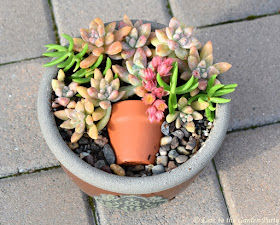This week I'm focusing on what I call my Eucalyptus Bed. That description wouldn't make any sense to anyone who's seen my garden since February 2013, when the tree was cut down at the behest of a neighbor that claimed it blocked her view.
 |
| This photo was taken in early February 2013, just days before the tree was cut down. You can learn more about the tree's sad story here. |
When the tree was removed I was left with a good-sized bed to plant.
 |
| Photo taken mid-February 2013 after the site was cleaned up and my husband added the cement block wall on the west side |
I started planting the area with some pretty perennials, like Heuchera and Argyranthemum, and annual flowers. I tried shrubs like Loropetalum. They didn't hold up well. I planted Helichrysum, which did too well and quickly became an unmanageable mess. I tried a Japanese maple but it couldn't stand up to the wind that regularly sweeps through the area. I tried a Drimys lanceolata but it was slow-growing and didn't make a statement. In 2014, I planted a row of Pennisetum 'Fireworks' along the wall, which has done well. In 2015 I added a couple of rockroses (Cistus) and in 2016 I added a smoke bush (Cotinus coggygria 'Royal Purple'). However, I've had a hard time getting anything established around the edges of the bed surrounding the shrubs, principally as the raccoons insist on repeatedly digging everything up. I'd added small succulents but I wasn't satisfied with those for long either.
 |
| This photo was taken earlier this week |
Last weekend, I started removing the succulents on the west edge of the bed. I'd already removed half of them by the time I thought to take the "before" photo shown above. I've ordered Agapanthus bulbs to plant around the smoke bush and added Liriope muscari 'Pee Dee Gold Ingot' around the edge this week. The Clematis vine growing up the arbor got a hard pruning too.
 |
| It's still a mish-mash |
Once I get the Agapanthus bulbs in, I expect I'll pull the 'Blue Boy' Yuccas as they're not looking good either. Whether this new design iteration of the bed will hold up in the long-term is anybody's guess.
 |
| This is the bed's "better" side but it could use work too |
The Graptoverias and Echeverias formerly in this bed were relocated to the adjacent succulent bed. However, I initially had no idea what to do with all the Graptosedum 'Darley Sunshine' you see in the "before" photo. I expect I'll use some cuttings in other succulent beds but, in the interim, I created 2 more of the succulent pots within pots featured on Instagram.
 |
| This one features a tiny one-inch pot surrounded by succulent cuttings |
 |
| I used a shell instead of another tiny pot in this one. The flowers are from Crassula 'Springtime'. |
Further proof that a garden is never "done."
All material © 2012-2019 by Kris Peterson for Late to the Garden Party










































